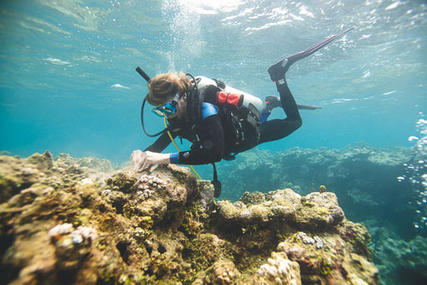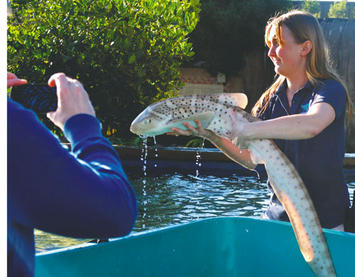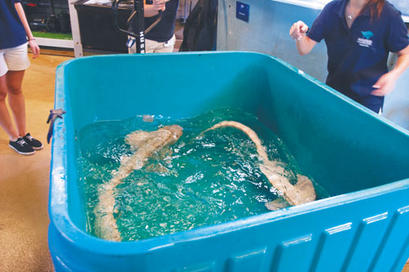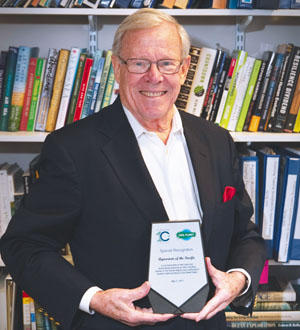Since its inception, the Aquarium of the Pacific has been a vocal advocate for protecting the environment and has worked toward a vision of healthier, cleaner oceans. In order to spread this message, the Aquarium attempts to bridge the gap between complex scientific messages and the general public, according to Sandy Trautwein, interim vice president of husbandry and curator of fish and invertebrates.
“What we’re finding now is that aquariums and zoos can play a much bigger role in facilitating conservation and research, particularly in the area of species recovery,” Trautwein said. “Many zoos and aquariums have very rare and endangered species and, through the propagation of those species, sometimes it’s the only chance for the survival of a particular species.”

Sandy Trautwein, interim vice president of husbandry and curator of fish and invertebrates, examines coral off the coast of Guam as part of the Aquarium’s partnership with SECORE, an organization dedicated to the conservation of the world’s coral reefs, to help spawn and culture corals in an aquarium setting to be out-planted in the reef. (Aquarium of the Pacific Photograph)
Internally, the Aquarium puts an emphasis on maintaining a sustainable animal collection, thereby reducing the demand for removing animals from the wild for its displays. The Aquarium has a program in which it breeds and cultures its own fish in order to repopulate its exhibits.
The Aquarium’s sustainable animal collection efforts serve more than itself. For example, AOP veterinarian Dr. Lance Adams focuses on the artificial insemination of zebra and bamboo sharks with the hopes of propagating the species in an aquarium setting to fulfill zoo and aquarium needs nationwide and internationally. His work led the Aquarium to become the first to successfully artificially inseminate and produce a zebra shark.
“We were also the first aquarium to breed and raise weedy seadragons, which is an endangered species off the southern coast of Australia,” Trautwein said. “They are a pretty rare species but we were able to breed that species here and then share them with other aquariums throughout the world, including Germany.”

A zebra shark bred at the Aquarium is introduced to its new home in Shark Lagoon. (Aquarium of the Pacific Photograph)
In general, Trautwein said the Aquarium is not a conservation and research institute in and of itself, but rather that it facilitates such activities by providing an outlet for outside researchers and conservation biologists. The Aquarium has an in-depth application process in which proposals can be submitted for consideration. Trautwein said many proposals are from local university professors or graduate students looking to partner with the Aquarium and utilize its resources.
For example, Trautwein explained that, if a university professor hoped to study sharks in partnership with the Aquarium, a research proposal would be submitted to a committee to ensure it is in line with the Aquarium’s mission and vision. If approved, the Aquarium would then assist in the research however possible.
One of the Aquarium’s biggest research and conservation projects is its work with the National Oceanic and Atmospheric Administration helping in the recovery of the endangered white abalone. Trautwein said the Aquarium is culturing white abalone onsite in order to out-plant them in the wild and recover the natural population. The Aquarium also works with reef restoration in Guam with its nonprofit partner SECORE (SExual COral REproduction). The efforts revolve around helping to spawn and culture corals in an aquarium setting to be out-planted in reefs around Guam annually.

The Aquarium of the Pacific was the first aquarium to successfully artificially inseminate and produce a zebra shark. (Aquarium of the Pacific Photograph)
“Our philosophy has always been that, if we can offer a unique, engaging experience to our guests through exciting animal displays or even interactive experiences like touching sharks and jellys, that can help facilitate environmental stewardship,” Trautwein said. “The more people we can engage and say, ‘Look, here are the beautiful animals but also they’re in trouble and need your help,’ the more we can hopefully inspire change. I think we can really make a positive difference for our future.”
Other conservation efforts at the Aquarium include upgrades to the space itself to be more environmentally friendly, studying sustainable seafood production, whale research, its scientific dive program, reducing single-use plastics, and working toward a climate-resilient Long Beach.
In 2015, Mayor Robert Garcia announced his intention of making Long Beach a climate-resilient city and requested the Aquarium to conduct an assessment related to climate change. The result of the Aquarium’s effort was an 89-page report, which indicated the greatest impacts of climate change on the city.
“Around the globe there are general things that are going to happen because of climate change but every location might see a slightly different acute effect based on that location,” David Bader, director of education at the Aquarium, said. “Here in Long Beach . . . in the coming years heat, drought, air quality and sea level rise are going to be the major impacts of climate change that will be the largest threat.”
Last year, to bring the climate resilience conversation to the community, Aquarium educators launched a Twitter page, @resilientLBaop, traveled throughout the community with a special booth and released pamphlets as quick reference guides to the data they have gathered on climate change impacts on Long Beach. These efforts were funded by grants from the National Science Foundation and funds from the California Coastal Commission’s Whale Tail license plate program.

Aquarium President and CEO Jerry Schubel holds a recognition plaque commemorating the 10th anniversary of The Climate Registry, a nonprofit organization dedicated to the global reduction of emissions, presented to the Aquarium on May 17, 2017. The plaque reads: “In commemoration of their vision and environmental leadership as both a founding member of The Climate Registry and a participant in Southern California Edison’s Cool Planet Project.” (Aquarium of the Pacific Photograph)
The Aquarium holds Community Conversation workshops to engage community leaders in the discussion about climate resilience in order to highlight the need of the public to think and act upon strategies to become more climate resilient as a city, as the impacts of climate change worsen. Bader explained that climate change mitigation efforts have an effect over a long period of time, whereas climate resilience efforts have a much more immediate impact, such as water conservation in order to prepare for increased droughts.
Bader said that, through the process of developing its report, Aquarium staff realized cultural science institutions such as the AOP can play a much larger role in the communities they are based in. Being located in Long Beach, Bader said the Aquarium can connect with and engage the city’s residents regarding topics such as climate change and climate resilience in ways it can’t with other communities.
“We ask people what they love about Long Beach and then what they would be willing to do to protect it from climate change in the future. Having those kinds of conversations and focusing on the aspirations of our communities, we can be a better neighbor,” Bader explained. “We can be a better servant of Long Beach to support the various diverse communities to be resilient and be able to bounce back in the face of the challenges we are going to have because of climate change.”
